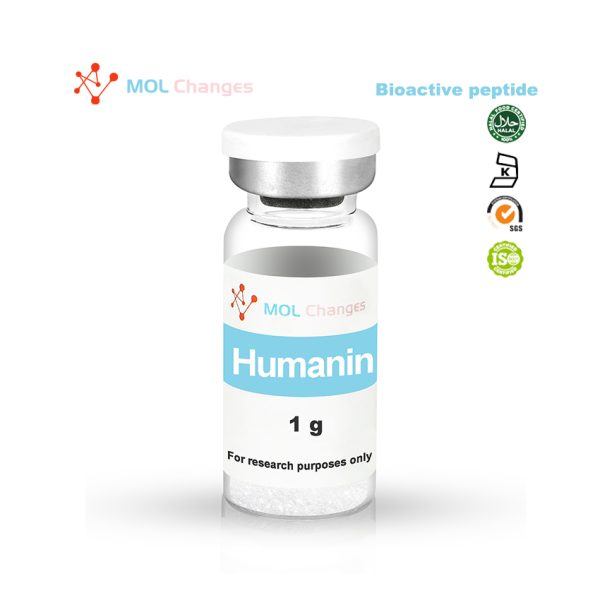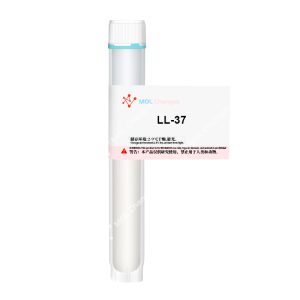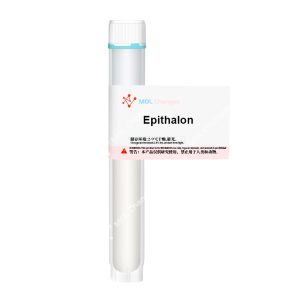Humanin is a naturally occurring micro-peptide unique for the fact that it is encoded in the mitochondrial DNA (mitochondria contain a small amounts of DNA that is exclusive only to them). It functions as a cytoprotective protein, protecting cells from the process of apoptosis (programmed cell death) via interference with the normal operation of the Bcl2-associated X protein (Bax). Variations of humanin have been found in a number of mammals from humans to rats and is highly conserved across species[1]. Research shows that humanin is important in protecting neurons, cardiac tissue, muscle cells, the retina of the eye, and the lining of blood vessels.
Sequence
Met-Ala-Pro-Arg-Gly-Phe-Ser-Cys-Leu-Leu-Leu-Leu-Thr-Ser-Glu-Ile-Asp-Leu-Pro-Val-Lys-Arg-Arg-Ala
CAS Number
330936-69-1
Molecular Formula
C119H204N34O32S2
Molecular Weight
2687.3
Humanin Related research
Unlike standard peptides and proteins, which are produced through posttranslational modification of larger peptides, micro-peptides are produced by short, open reading frames (sORFs) and do not undergo modification once they are produced. Ranging in size from 100-150 amino acids in length, sORFs were originally overlooked by researchers convinced that all peptides were produced by the same process of DNA to RNA to protein to modified protein. No one considered that the last step, modification, could be disregarded entirely.
In humans, a number of sORFs have been identified. Their functions range from enhancing mRNA processing to helping to repair DNA damage and interacting with other proteins to create complex macro-proteins. Humanin, one of the smallest micro-peptides known to date, is just 24 amino acids in length. It interacts with the Bcl2-associated X protein (Bax) to regulate apoptosis, blocking the function of Bax when necessary to preserve cells that would otherwise be destroyed.
Neuroprotection
Research in rats indicates that humanin protects not just against apoptosis, but against programmed cell death in specific situations. In particular, the micro-peptide has been shown to protect neurons in the setting of Alzheimer’s disease, preventing the cell death that is induced by beta-amyloid plaque build-up[3]. Research shows that the peptide protects against excitotoxic neuron death in experiments using NMDA pulses[1].
Similar results to the above experiments were obtained when investigating neuron death occurring secondary to prion disease[4]. There is hope that this function of humanin can be exploited to slow or even halt neurodegenerative diseases like Alzheimer’s disease and other forms of dementia. Though it does not strike at the heart of the conditions (e.g. the formation of amyloid plaques in Alzheimer’s disease) humanin could be critical in tipping the delicate physiologic balance that plays out in these conditions, favoring the suspension of apoptosis[5].
Humanin appears to protect neurons through two different mechanisms, both of which have the ultimate function of preventing mitochondria from activating the apoptosis pathway. Under normal circumstances, the Bcl-2 family of proteins signal the release of proteins from the mitochondrial membrane, which in turn activate caspases that coordinate the orderly destruction and recycling of a cell[6]. This process is actually useful in many settings, such as during viral invasion, when the destruction of a handful of cells can prevent widespread tissue damage. Unfortunately, the process may become dysregulated in certain disease conditions with the result being unrestrained, widespread cell death. Humanin binds to Bcl-2 stimulating proteins Bid and tBid and blocks their function, thereby shutting down the apoptosis pathway at its origin[7].
Cutting edge research out of Argentina has found that humanin is actually released by astrocytes to protect synapses in hippocampal neurons[8]. As with many natural regulatory processes, there is some thought that humanin function may decline with age, thereby allowing for age-related memory loss and the increased prevalence of neurodegenerative disease. Some researchers speculate that there may be a role for humanin supplementation in older adults and a means of offsetting normal age-related declines in the production of this critical micro-peptide.
Humanin Interfaces with IGF-1
Recent research from the University of Southern California has revealed that humanin interacts with insulin-like growth factor 1 (IGF-1). In fact, the two peptides interact with one another, with humanin decreasing circulating levels of IGF-1 and IGF-1 influencing levels of humanin. Though the mechanism of this interact has yet to be fully elucidated, scientists find the evidence compelling that humanin is a new and potentially important player in IGF-1 signaling. The peptides have synergistic effects in a number of ways and work together to inhibit apoptosis, boost insulin sensitivity, reduce inflammation, and protect against certain forms of heart disease. In other cases, the peptides play antagonist roles. More research is needed to elucidate the exact ways in which IGF-1 and humanin influence one another, but that they do is an established fact[9].
Heart Disease
Research out of the Mayo Clinic, America’s premiere healthcare institution, reveals that humanin is expressed in the walls of human vasculature and helps to protect blood vessels from the effects of oxidized LDL (bad) cholesterol. In particular, humanin interferes with the production of reactive oxygen species (free radicals) in response to LDL oxidation. In so doing, it reduces reactive oxygen species in the vasculature by 50% and reduces apoptosis by 50% as well[10].
It has already been established that humanin levels decline with age, but new research suggests that the micro-peptide may also be affected by certain disease states. Researchers in cardiology have long sought to find blood markers that can be used to quantify how effectively mitochondria are functioning in the setting of cardiovascular disease. This is a critical measure of health in patients with heart disease because it gives a good estimate of how ischemic the tissue is and how advanced the disease is and may be useful in deciding when intervention is necessary. Research out of Russia shows that humanin levels may be a good marker in this setting as the decline in proportion to the severity of cardiovascular disease[11]. In this cause, humanin may serve as both a diagnostic marker and as a potential treatment for the same condition as supplementation with humanin is likely to protect the already stressed mitochondria.
Humanin Research and Retinal Disease
The retinal pigment epithelium (RPE) is a layer of the retina the overlies and nourishes the cells responsible for vision. It plays roles in absorbing and scattering light, filtering the blood components that reach the inner retina, and establishes the immune-privileged nature of the inner eye among other things. Damage to the RPE is seen in age-related macular degeneration as well as diabetic retinopathy and a handful of other common, serious diseases of the eye. Research now indicates that humanin is an important component in the RPE and that it decreases oxidative stress in this tissue. Supplementation with humanin, in cell culture, improves RPE function and increases the tissue’s resistance to apoptosis [12]. There is hope that this may help scientists to establish more effective treatment and preventative strategies for retinal diseases like macular degeneration.
Bone Health
Bone loss is a serious condition that affects may people, particularly women, as they age. It is also a consequence of a number of disease states and is even caused by certain medical interventions. In the latter category, glucocorticoids used to treat severe inflammation (e.g. autoimmune inflammation) are the most notorious player and are known to cause extreme bone loss when used in high doses or for prolonged periods of time. Researchers in Sweden and Korea have discovered that humanin may be beneficial to bones in two different ways. First, the micro-peptide has been found to prevent the death of chondrocytes (the cells that produce the collagen matrix on which bone is built) without interfering with the anti-inflammatory effects of glucocorticoids like dexamethasone[13]. This effect helps to boost rates of bone and cartilage growth, offsetting some of the accelerated bone loss caused by glucocorticoids. At the same time that humanin promotes chondrocyte development, it appears to reduce osteoclast formation. Osteoclasts are the cells responsible for bone breakdown and remodeling. While useful and important in normal physiologic function, over-activation of these cells in pathologic states leads to severe bone loss. By preventing osteoclast formation, humanin helps to reduce excessive bone remodeling and loss[14].
COA
HPLC
MS
- A. Caricasole, V. Bruno, I. Cappuccio, D. Melchiorri, A. Copani, and F. Nicoletti, “A novel rat gene encoding a Humanin-like peptide endowed with broad neuroprotective activity,” FASEB J. Off. Publ. Fed. Am. Soc. Exp. Biol., vol. 16, no. 10, pp. 1331–1333, Aug. 2002.
- PubChem, “Humanin.” [Online]. Available: https://pubchem.ncbi.nlm.nih.gov/compound/16131438. [Accessed: 11-Sep-2019].
- M. Matsuoka, “Humanin; a defender against Alzheimer’s disease?,” Recent Patents CNS Drug Discov., vol. 4, no. 1, pp. 37–42, Jan. 2009.
- I. Sponne, A. Fifre, V. Koziel, B. Kriem, T. Oster, and T. Pillot, “Humanin rescues cortical neurons from prion-peptide-induced apoptosis,” Mol. Cell. Neurosci., vol. 25, no. 1, pp. 95–102, Jan. 2004.
- A. R. White et al., “Sublethal concentrations of prion peptide PrP106-126 or the amyloid beta peptide of Alzheimer’s disease activates expression of proapoptotic markers in primary cortical neurons,” Neurobiol. Dis., vol. 8, no. 2, pp. 299–316, Apr. 2001.
- C. Wang and R. J. Youle, “The Role of Mitochondria in Apoptosis,” Annu. Rev. Genet., vol. 43, pp. 95–118, 2009.
- D. Zhai, F. Luciano, X. Zhu, B. Guo, A. C. Satterthwait, and J. C. Reed, “Humanin binds and nullifies Bid activity by blocking its activation of Bax and Bak,” J. Biol. Chem., vol. 280, no. 16, pp. 15815–15824, Apr. 2005.
- S. C. Zárate, M. E. Traetta, M. G. Codagnone, A. Seilicovich, and A. G. Reinés, “Humanin, a Mitochondrial-Derived Peptide Released by Astrocytes, Prevents Synapse Loss in Hippocampal Neurons,” Front. Aging Neurosci., vol. 11, p. 123, 2019.
- J. Xiao, S.-J. Kim, P. Cohen, and K. Yen, “Humanin: Functional Interfaces with IGF-I,” Growth Horm. IGF Res. Off. J. Growth Horm. Res. Soc. Int. IGF Res. Soc., vol. 29, pp. 21–27, 2016.
- A. R. Bachar et al., “Humanin is expressed in human vascular walls and has a cytoprotective effect against oxidized LDL-induced oxidative stress,” Cardiovasc. Res., vol. 88, no. 2, pp. 360–366, Nov. 2010.
- A. A. Zhloba, T. F. Subbotina, N. S. Molchan, and Y. S. Polushin, “[The level of circulating humanin in patients with ischemic heart disease.],” Klin. Lab. Diagn., vol. 63, no. 8, pp. 466–470, 2018.
- Sreekumar, Parameswaran & Ishikawa, Keijiro & Spee, Chris & Mehta, Hemal & Wan, Junxiang & Yen, Kelvin & Kannan, Ram & Hinton, David. (2016). The Mitochondrial-Derived Peptide Humanin Protects RPE Cells From Oxidative Stress, Senescence, and Mitochondrial Dysfunction. Investigative Opthalmology & Visual Science. 57. 1238. 10.1167/iovs.15-17053.
- B. Celvin, F. Zaman, C. Aulin, and L. Sävendahl, “Humanin prevents undesired apoptosis of chondrocytes without interfering with the anti-inflammatory effect of dexamethasone in collagen-induced arthritis,” Clin. Exp. Rheumatol., Jun. 2019.
- N. Kang, K. W. Kim, and D. M. Shin, “Humanin suppresses receptor activator of nuclear factor-κB ligand-induced osteoclast differentiation via AMP-activated protein kinase activation,” Korean J. Physiol. Pharmacol. Off. J. Korean Physiol. Soc. Korean Soc. Pharmacol., vol. 23, no. 5, pp. 411–417, Sep. 2019.
Article/Literature Citation Notes
The purpose of quoting the scientist and professor's article is to acknowledge, recognise and applaud the exhaustive development work that has been done to undertake this peptide research. The scientist does not in any way support or advocate the purchase, sale or use of this product for any reason, and MOL Changes has no affiliation or relationship, implied or otherwise, with the scientist.
warning
These products are intended for scientific purposes only for in vitro research and are not to be used for human, animal or unethical experiments, in vitro research (Latin: in glass) is conducted in vitro. These products are not drugs and are not approved by the Food and Drug Administration in any country for the prevention, treatment or cure of any medical condition, disease or illness. The introduction of this product into humans or animals in any form is strictly prohibited by law.






